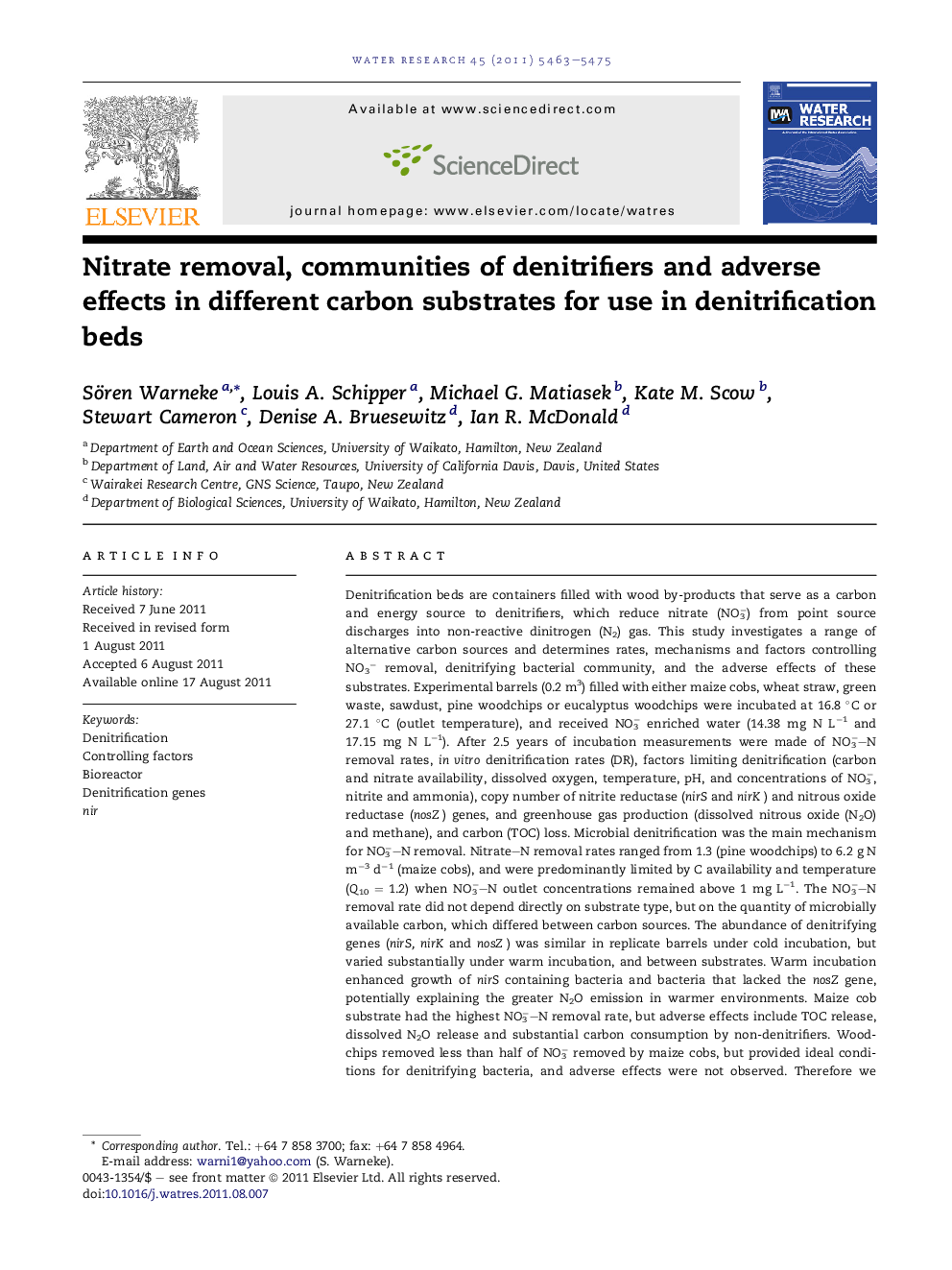| کد مقاله | کد نشریه | سال انتشار | مقاله انگلیسی | نسخه تمام متن |
|---|---|---|---|---|
| 4483166 | 1316880 | 2011 | 13 صفحه PDF | دانلود رایگان |

Denitrification beds are containers filled with wood by-products that serve as a carbon and energy source to denitrifiers, which reduce nitrate (NO3−) from point source discharges into non-reactive dinitrogen (N2) gas. This study investigates a range of alternative carbon sources and determines rates, mechanisms and factors controlling NO3− removal, denitrifying bacterial community, and the adverse effects of these substrates. Experimental barrels (0.2 m3) filled with either maize cobs, wheat straw, green waste, sawdust, pine woodchips or eucalyptus woodchips were incubated at 16.8 °C or 27.1 °C (outlet temperature), and received NO3− enriched water (14.38 mg N L−1 and 17.15 mg N L−1). After 2.5 years of incubation measurements were made of NO3−–N removal rates, in vitro denitrification rates (DR), factors limiting denitrification (carbon and nitrate availability, dissolved oxygen, temperature, pH, and concentrations of NO3−, nitrite and ammonia), copy number of nitrite reductase (nirS and nirK) and nitrous oxide reductase (nosZ) genes, and greenhouse gas production (dissolved nitrous oxide (N2O) and methane), and carbon (TOC) loss. Microbial denitrification was the main mechanism for NO3−–N removal. Nitrate–N removal rates ranged from 1.3 (pine woodchips) to 6.2 g N m−3 d−1 (maize cobs), and were predominantly limited by C availability and temperature (Q10 = 1.2) when NO3−–N outlet concentrations remained above 1 mg L−1. The NO3−–N removal rate did not depend directly on substrate type, but on the quantity of microbially available carbon, which differed between carbon sources. The abundance of denitrifying genes (nirS, nirK and nosZ) was similar in replicate barrels under cold incubation, but varied substantially under warm incubation, and between substrates. Warm incubation enhanced growth of nirS containing bacteria and bacteria that lacked the nosZ gene, potentially explaining the greater N2O emission in warmer environments. Maize cob substrate had the highest NO3−–N removal rate, but adverse effects include TOC release, dissolved N2O release and substantial carbon consumption by non-denitrifiers. Woodchips removed less than half of NO3− removed by maize cobs, but provided ideal conditions for denitrifying bacteria, and adverse effects were not observed. Therefore we recommend the combination of maize cobs and woodchips to enhance NO3− removal while minimizing adverse effects in denitrification beds.
► Microbial denitrification was the main mechanism for nitrate removal for all carbon substrates examined.
► Nitrate–N removal rates of different carbon substrates were limited by C availability and temperature (Q10 = 1.2).
► Warm incubation enhanced growth of nirS containing bacteria and bacteria that lacked the nosZ gene, potentially explaining the greater N2O emission in warmer environments.
► Maize cob had highest NO3−–N removal rate, but also adverse effects (TOC release, dissolved N2O release and substantial carbon consumption by non-denitrifiers).
► Woodchips removed less NO3− than maize cobs, but had no adverse effects and provided ideal conditions for growth of denitrifier.
Journal: Water Research - Volume 45, Issue 17, 1 November 2011, Pages 5463–5475